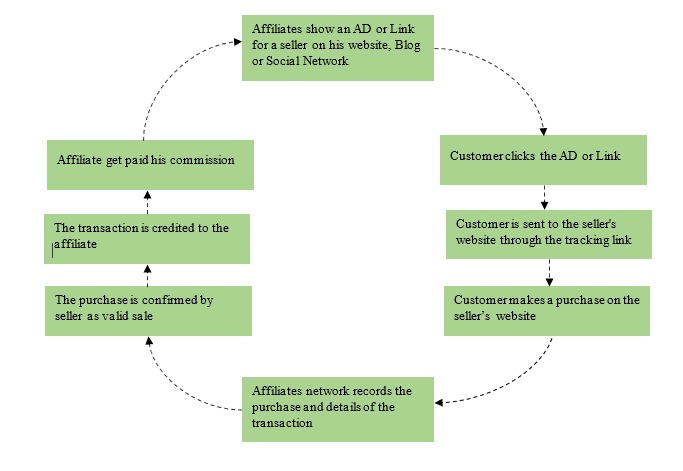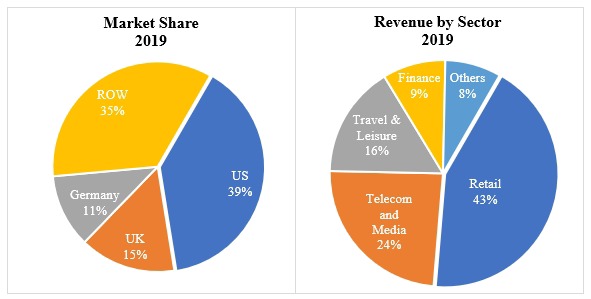Affiliate Marketing Statistics & Trends Globally (2022)

Affiliate marketing has become a key source of online income for many professional bloggers. The idea of affiliate marketing first conceptualized by William J. Tobin in 1989 and boomed in 1996 when Amazon associated Befree and Linkshare (now Rakuten) launched the first affiliate program and produced major successes of the affiliate marketing industry.
Overview of Affiliate Marketing Statistics & Trends Globally (2021)
Affiliate marketing is a very popular and one of the best ways to earn money online. As a beginner or experienced marketer or blogger, you can promote other people’s products on your blog, email list, and social media accounts to earn money. Most common affiliate program offered are cost per acquisition, cost per lead, cost per sale and cost per click
Some facts on Affiliate Marketing
- 15% of the total digital media advertising revenue is attributed to affiliate marketing.
- Affiliate programs generate 15%–30% of all sales for advertisers.
- More than 50% of affiliate-referred traffic comes from mobile devices.
- Annual affiliate marketing spending is estimated at US$12 billion
- Driving conversions and increasing purchases are the two main goals for 79% of marketers
Market Overview
- Affiliate marketing spending is expected to grow by 10% in the next few years.
- The global value of the affiliate marketing industry is estimated at US$12 billion.
- With the US market accounting for $4.5 billion of affiliate marketing market share. USA accounts for 39% of the global affiliate marketing market followed by UK and Germany which accounts for 15% and 11%.
- The retail sector contributes 43% of total affiliate marketing market revenue followed by telecom and media, travel and leisure sector which contributes 24% and 16% respectively.
Inforgraphic

Share this Image On Your Site
Companies built on Affiliate Commissions
- Groupon – US based e-commerce company with 6,672 employees. It connects subscribers with local merchants offering activities, travel, and goods ad service. It generated US$2.6 billion in revenue in 2018. It has reached 50 million active users
- Moneysupermarket Group – UK based price comparison website. It enables consumers to compare prices of financial services products including car insurance, home insurance, mortgages and credit cards, etc. It generated US$452 million in revenue in 2018
- Internet Brands – US-based media company. It operates online media, community, and e-commerce sites. It operates 200+ websites and generated revenue of US$258 million. It was acquired by KKE & Co. in 2014
Top Affiliate Networks
- ShareASale – US based affiliates networks. It currently has over 4,500 merchant programs on its platform and over 1,000,000 affiliates participating. It was acquired by Affiliate window
- Rakuten Affiliate Network – US based affiliate marketing service provider. It focussed mostly on physical goods and currently has over 1,000 merchants. The program it offered are cost per acquisition, cost per lead, cost per sale and cost per click
- CJ Affiliates – US based an online advertising company owned by Alliance Data. This affiliate marketing network specializes in pay-for-performance programs and boasting more than 3,000 merchants. They operate globally and has key partners including Home Depot, Apple, TurboTax, and Zappos
- Peerfly – US-based affiliate marketing network. Operates on a cost-per-action basis, which means advertisers only pay for every action completed. It has 75,000 active publisher accounts around the globe and over 250,000 accounts in total that are responsible for more than 1 billion clicks and 8 million transactions
How does Affiliate Marketing Work?
There are three parties involved in the process:
- Seller and product creators – A vendor merchant, product creator, or retailer with a product to market. The seller does not need to be actively involved in the marketing but they share the profit with the affiliate.
- The affiliate or advertiser – The affiliate can be either an individual or a company that markets the seller’s product to potential consumers. If the consumer buys a product from the link shared, the affiliate receives a portion of the revenue made.
- The consumer – Affiliates share these products to consumers on social media, blogs, and websites and when consumers buy the product, the seller and the affiliate share the profits.

An affiliate program uses a cookie to track the user’s online activity. Cookie has definite life and the referral needs to purchase within the lifecycle of cookie otherwise the lead will no longer be trackable and the affiliate will not get his commission.
Type of Affiliate Marketing
- Influencers – An individual who holds the power to impact the purchasing decisions of another person. It’s easy for them to direct consumers to the seller’s products through social media posts, blogs, and other interactions with their followers
- Bloggers – The blogger writes reviews of the seller product and services and promotes the brand, driving traffic to the seller’s site
- Paid search focused microsites – These sites are advertised within a partner site or on the sponsored listings of a search engine. It offers content focussed for a specific audience and it leads to increased conversion rate
- Email lists – It is an old and effective way of affiliate marketing to promote the seller’s products. The affiliate sends an email newsletter that includes hyperlinks to products to target people and earns commission after the consumer purchase the product
- Large media websites – These sites are created with a focus on building a huge audience and they promote seller’s products to these audiences through the use of banners and contextual affiliate links.

Global affiliate marketing spending growing at 27% CAGR while US spending is growing at 10% CAGR from 2015 to 2020 and UK spending in 2017 grew by 15.1%. In 2017 traffic originates by the affiliate from mobile devices was 50% while market spending on smartphones increased by 49% in 2017
Key Takeaways on Affiliate Marketing
- Unlike most marketing channels, the seller only pays per transaction with affiliate marketing. In other words, the seller only spends money when the seller makes money. This strategy is important for small businesses that have limited resources to spend on advertising.
- It’s easy for anyone to be an affiliate — even if an affiliate doesn’t have a website and he can rely on aff social media channels, entirely.
- Affiliate marketing spending has grown by 27% CAGR and expected to grow by 10% in the next few years.
- US, UK, and Germany together hold 65% of the total affiliate market share while the retail sector accounted for 43% of total affiliate industry revenue.
More To Explore
Wearable Statistics And Facts For 2021
Industry report Overview of Wearable Statistics And Facts For 20211
Facebook live Statistics, Usage And Facts (2020 Report)
Industry report Overview of Facebook live Statistics, Usage And Facts
Web Hosting Statistics, Market share And Facts For 2021
Industry report Overview of Web Hosting Statistics, Market share And
Explore Related reccomendations
Wearable Statistics And Facts For 2021
- According to 0 users
Video Marketing Statistics And Facts For 2019
- According to 0 users
SMS Marketing Statistics And Facts For 2020
- According to 0 users
2019 Bitcoin Statistics, Trends & Data
- According to 0 users



